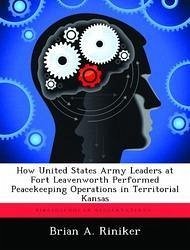The Army in the Kansas Territory (Bleeding Kansas) engaged in what is now called Peacekeeping and Peace-Enforcement Operations. This thesis examines how the Army performed those operations, compares its actions to the United Nations (UN) basic definitions of Peacekeeping, and explores how the lessons learned in Kansas could apply to the modern era. The Army in Kansas faced a major problem: How to regain and maintain peace in a territory that had a population divided over the issue of slavery and local governmental control. This problem was complicated by the existence of two separate territorial governments: One legal (proslavery) but not recognized by the majority of the Kansas population; the other an illegal (antislavery) organization that had greater popularity with the residents of the territory. The Army also had to modify its actions due to several factors: The legality issues of militarily engaging American citizens; the variety of personalities and skills of several territorial governors; the national attention drawn to the conflict; and the other responsibilities the Army faced on the western frontier (Native American and Mormon uprisings). The primary lessons learned were the need to use a professional, disciplined force to stabilize the region, the need for military leadership and civilian leadership to work together to develop solutions to a crisis, and the need for the military to encourage civilian control over political solutions to a crisis. This work has been selected by scholars as being culturally important, and is part of the knowledge base of civilization as we know it. This work was reproduced from the original artifact, and remains as true to the original work as possible. Therefore, you will see the original copyright references, library stamps (as most of these works have been housed in our most important libraries around the world), and other notations in the work. This work is in the public domain in the United States of America, and possibly other nations. Within the United States, you may freely copy and distribute this work, as no entity (individual or corporate) has a copyright on the body of the work. As a reproduction of a historical artifact, this work may contain missing or blurred pages, poor pictures, errant marks, etc. Scholars believe, and we concur, that this work is important enough to be preserved, reproduced, and made generally available to the public. We appreciate your support of the preservation process, and thank you for being an important part of keeping this knowledge alive and relevant.
Bitte wählen Sie Ihr Anliegen aus.
Rechnungen
Retourenschein anfordern
Bestellstatus
Storno






